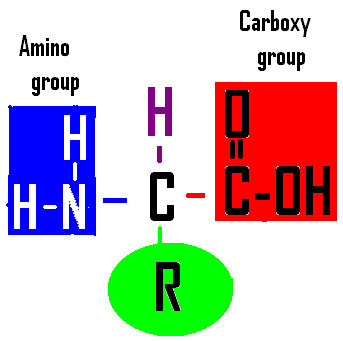
Image by Riedell
4. This molecule could be joined with others like it to make a
______________________.
PRACTICE SEMESTER TEST-
Honors Biology
I
Write answers on a piece of paper then check at the end OR open two
internet windows and keep checking answers at the bottom as you go.
Intro to Biology
Chapters 1 & 2
1. ____________________ would be an example of an autotroph.
2. A water molecule is said to be ___________ because it has an uneven pattern of charge on it.
polar non-polar Organic unicellular
 Image by Riedell |
3. This molecule is a(n)
____________________.
4. This molecule could be joined with others like it to make a |
5. The proteins with sugars attached that help cells to "recognize self" are called ________________________
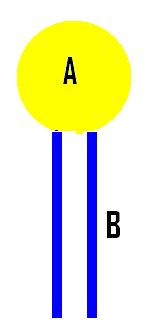 |
6. Which part of this phospholipid molecule is POLAR?
A B |
7. DNA and RNA are ___________________
A. carbohydrates
B. nucleic acids
C. lipids
D. proteins
Cell Structure and Function & Transport
Chapter 7
8. What does a lysosome do?
9. Which of these organelles is missing in
bacteria?
cell membrane
nuclear membrane
cell wall
ribosomes
10. Cells with NO nuclear membrane or membrane bound organelles are called _____________________
prokaryotes eukaryotes
| 11. The function of this organelle is to ________________________ |
12. Molecules always want
to move from _____________________
a.) an area of higher concentration to lower concentration
b) an area of lower concentration to higher concentration
13.
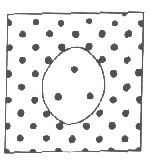
13. This diagram shows a cell placed in a solution. Black dots represent
solute molecules.
The cell in this picture is in a _______tonic solution.
14. What will happen to the cell above?
It will shrink
It will swell and explode
It will stay the same size
15. Transport proteins that move water across a cell membrane are called _______________
16. Tell the cell part involved in APOPTOSIS
Cell Reproduction
Chapter 10
|
17. As a cell increases in size, its surface area to volume ratio (SA/V) ____________. increases decreases |
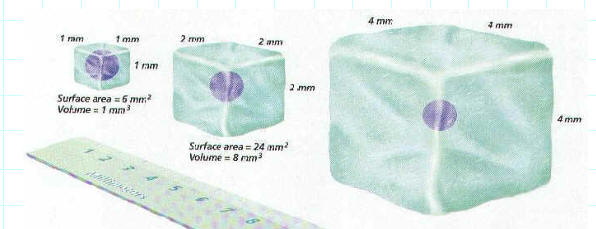 |
18. The area of an animal cell membrane that pinches in during cytokinesis the ___________________.
19. The phase of the cell cycle which follows G1 phase is
S M C G2
20. Which phase of mitosis could also be called "reverse prophase"?
21. Plant cells undergo cytokinesis by forming a _______________ instead of a cleavage furrow.
Genetics
Chapter 11
22. Tall (T) peas are dominant over short (t) peas.
If you cross homozygous tall
peas with homozygous short peas, what percent of the offspring will be short?
none 25% 50% 100%
23. The way an organism looks is its ________________
genotype phenotype
24. Crossing a PURE RED flowered plant with a PURE WHITE flowered plant and getting ALL PINK flowered offspring is a example of _________________
Codominance
Complete dominance
Incomplete dominance
25. If you crossed parents that were heterozygous for 2 traits, what phenotypic ratio would you expect to see in the offspring?
26. How are telomeres in cancer cells different than normal cells?
27. Harmful genetic disorders (like sickle cell anemia) stay in populations even though they harm some individuals because they are helpful to people who only have one copy of the gene. This is called _______________ ________________

28. The diagram above that is used to show how traits are passed on is called a _________________.
29. Genes carried on the X chromosome are said to be _________________
DNA, RNA, and PROTEINS
Chapter 12
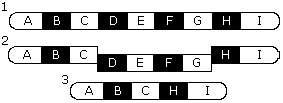 |
30. Name the mutation shown in the picture at the left. |
 Codon wheel from: BIOLOGY by Miller and Levine; Prentice Hall Publishing©2006 |
31. Tell
the amino acid sequence coded for by this mRNA
U A C G C A G G U |
|
32. What
do we call the small pieces of DNA that are edited out of the mRNA message
before it is expressed? |
33. Making an RNA message from a sequence of DNA is called _________________
34. Tell the kind of RNA that has an ANTICODON region and is attached to an amino acid.
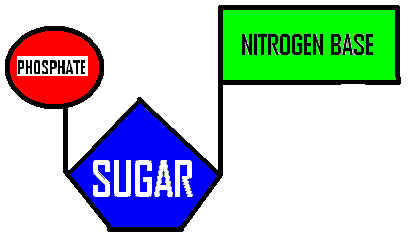 |
35. Name this subunit used to
make nucleic acids.
36. If you were using this to make DNA |
37. Another name for transposons is _______________________
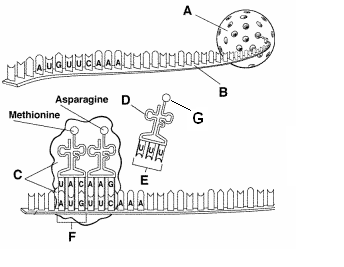 ©Pearson Education Inc; Publishing as Pearson Prentice Hall; |
38. E = ?
39. F = ? 40. G = ?
|
1. green plant
2. polar
3. amino acid
4. protein
5. glycoproteins
6. A- the head is polar
7. DNA & RNA are nucleic acids
8. contain digestive enzymes
9. nuclear membrane
10. prokaryotes
11. burn glucose and store energy as ATP
12. A. higher to lower
13. HYPERtonic
14. It will shrink
15. aquaporins
16. lysosomes
17. volume increases faster than surface area- IT DECREASES.
18. cleavage furrow
19. S
20. telophase is reverse prophase
21. cell plate
22. none will be short/100% will be tall
23. phenotype
24. incomplete dominance
25. 9:3:3:1
26. Cancer cells replace their lost telomeres so they can keep on dividing.
Telomere length in normal cells decreases with age
(number of divisions).
27. heterozygote advantage
28. pedigree chart
29. sex linked
30. deletion
31. tyrosine-alanine-glycine
32. introns
33. transcription
34. transfer RNA or t-RNA
35. nucleotide
36. deoxyribose
37. jumping genes
38. anticodon
39. codon
40. amino acid
|
Use of our material: All
original materials link are created by
We have worked very hard on activities, Powerpoints/games/worksheets, etc to make
this a resource for our students. If you are using our materials, please give us
credit for our efforts by listing us as a source with links to our site. DO NOT
USE these materials for commercial purposes.
PLEASE DO NOT POST
ANSWER KEYS FOR OUR MATERIALS TO OTHER WEBSITES! |